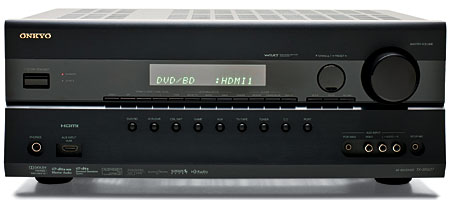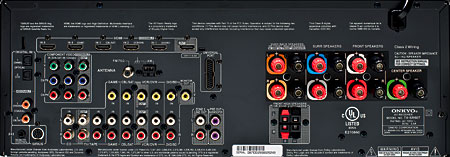Onkyo TX-SR607 A/V Receiver
 Price: $599 At A Glance: First receiver with Dolby Pro Logic IIz height-enhanced surround • Faroudja DCDi video processing • Audyssey 2EQ auto setup and room EQ
Price: $599 At A Glance: First receiver with Dolby Pro Logic IIz height-enhanced surround • Faroudja DCDi video processing • Audyssey 2EQ auto setup and room EQ
We’re Gonna Get High
The Onkyo TX-SR607 is the first A/V receiver to feature Dolby Pro Logic IIz, which adds front height channels to the existing 5.1- and 7.1-channel configurations. Now gird yourself for deep background and fierce opinion mongering.

Surround sound has always been an evolving medium in home theater and cinematic applications. Its origins in home theater are nothing if not humble. The original Dolby Surround format uses matrix-encoding/decoding to extract a single monaural surround channel from an encoded stereo signal, which is distributed to a pair of surround speakers. Using the same two-channel signal and a similar matrixing technique, Dolby Pro Logic decoding adds a much-needed front center channel. Dolby Pro Logic II ups the surrounds to two full-range channels and also adds a subwoofer. Dolby Digital and DTS improve over these matrixed formats by delivering 5.1 discrete and wholly independent channels, thus eliminating channel leakage and liberating panning effects to range freely around the soundfield. So far, so good.
Then the rot sets in. THX Surround EX, now known as Dolby Digital EX, goes back to matrixing to encode/decode a monaural back-surround channel onto what are sometimes known as the side-surrounds, for a total of 6.1 channels that are typically delivered by six speakers plus a sub. Although DTS-ES Matrix does the same, DTS-ES Discrete actually delivers 7.1 discrete channels without using the matrix trick.
I have long railed against this back-surround flimflam because it usually uses an outmoded technique, matrixing, to deliver a dubious benefit, back-surrounds. In doing this, it taxes all the other channels’ power reserves, and it introduces unnecessary hardware and cabling. This results in a distribution of speakers that is simply absurd. As I have said to people in this industry hundreds of times: “Three speakers in front, four in back. What’s wrong with this picture?” By undermining what I regard as the 5.1-channel standard of surround sound, back-surrounds have endlessly confused consumers. They have also called into question the credibility of surround standard setters and undermined the adoption of surround sound in general, which ensures that many audio/video systems never move beyond stereo.
Now along comes Dolby Laboratories with a new technology to license to logo-conscious receiver manufacturers. Here’s the big question: Do we need height channels to augment the existing 5.1- and 7.1-channel arrays that are used in most home surround systems? You can guess how I feel about this, can’t you?
Height-Enhanced Pro Logic
The unlikely vehicle for this next-generation surround technology is the Dolby Pro Logic family. To oversimplify, the original Dolby Pro Logic uses matrixing to deliver a single, band-limited mono surround channel by sending anything not common to both front channels to the rear—in other words, left minus right. It also uses matrixing to create a front center channel. Dolby Pro Logic II does the job better in several ways. Most crucially, instead of providing a single surround channel with limited frequency response, it provides two surround channels that have full frequency response. Dolby Pro Logic IIx adds back-surrounds (boo, hiss).

Now the Pro Logic family has acquired a new member. Dolby Pro Logic IIz, like its siblings, is not strictly an encode/decode format like Dolby Digital. Rather, it operates as a listening mode on top of that. It does not deliver discrete height channels, and there is no height-encoded software (yet). Instead, as the Dolby Labs people initially explained to me, it extracts decorrelated non-surround elements from surround or stereo sources to create two new channels that should be placed above the front left and right. This bumps existing surround arrays from 5.1 or 7.1 channels to 7.1 or 9.1. Incidentally, the DTS people are contemplating height to front and rear, which would total 10.2, 11.2, or 12.2 channels—but we’ll get to that story as it develops.





























































